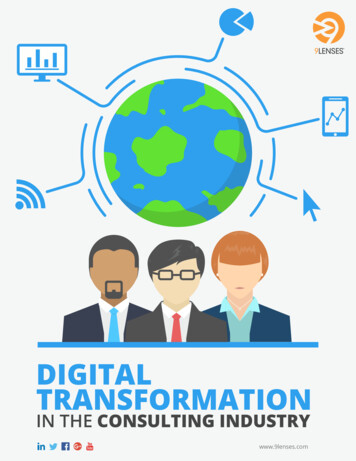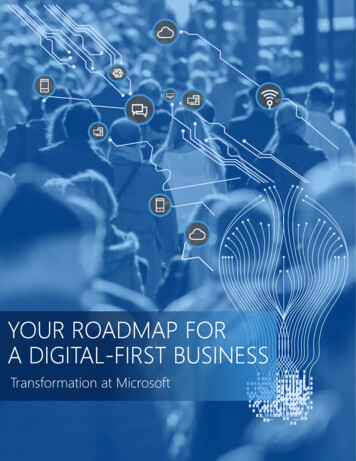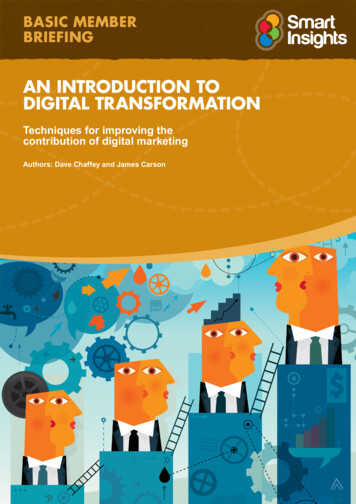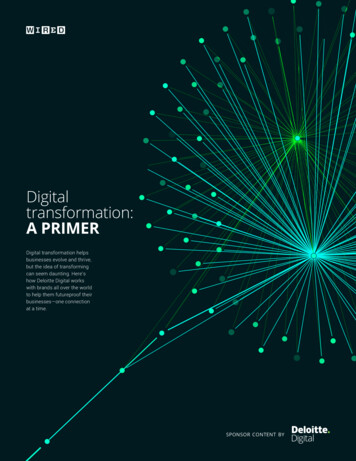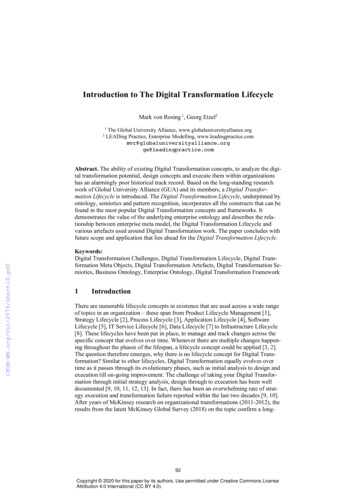
Transcription
Introduction to The Digital Transformation LifecycleMark von Rosing 1, Georg Etzel212The Global University Alliance, www.globaluniversityalliance.orgLEADing Practice, Enterprise Modelling, e.orgge@leadingpractice.comAbstract. The ability of existing Digital Transformation concepts, to analyze the digital transformation potential, design concepts and execute them within organizationshas an alarmingly poor historical track record. Based on the long-standing researchwork of Global University Alliance (GUA) and its members, a Digital Transformation Lifecycle is introduced. The Digital Transformation Lifecycle, underpinned byontology, semiotics and pattern recognition, incorporates all the constructs that can befound in the most popular Digital Transformation concepts and frameworks. Itdemonstrates the value of the underlying enterprise ontology and describes the relationship between enterprise meta model, the Digital Transformation Lifecycle andvarious artefacts used around Digital Transformation work. The paper concludes withfuture scope and application that lies ahead for the Digital Transformation Lifecycle.Keywords:Digital Transformation Challenges, Digital Transformation Lifecycle, Digital Transformation Meta Objects, Digital Transformation Artefacts, Digital Transformation Semiotics, Business Ontology, Enterprise Ontology, Digital Transformation Framework1IntroductionThere are numerable lifecycle concepts in existence that are used across a wide rangeof topics in an organization – these span from Product Lifecycle Management [1],Strategy Lifecycle [2], Process Lifecycle [3], Application Lifecycle [4], SoftwareLifecycle [5], IT Service Lifecycle [6], Data Lifecycle [7] to Infrastructure Lifecycle[8]. These lifecycles have been put in place, to manage and track changes across thespecific concept that evolves over time. Whenever there are multiple changes happening throughout the phases of the lifespan, a lifecycle concept could be applied [3, 2].The question therefore emerges, why there is no lifecycle concept for Digital Transformation? Similar to other lifecycles, Digital Transformation equally evolves overtime as it passes through its evolutionary phases, such as initial analysis to design andexecution till on-going improvement. The challenge of taking your Digital Transformation through initial strategy analysis, design through to execution has been welldocumented [9, 10, 11, 12, 13]. In fact, there has been an overwhelming rate of strategy execution and transformation failure reported within the last two decades [9, 10].After years of McKinsey research on organizational transformations (2011-2012), theresults from the latest McKinsey Global Survey (2018) on the topic confirm a long-92Copyright 2020 for this paper by its authors. Use permitted under Creative Commons LicenseAttribution 4.0 International (CC BY 4.0).
standing trend: few executives say their companies’ transformations succeeded. Today, just 26 percent of respondents say their digital transformations, have been successful at both improving performance and equipping the organization to sustain improvements over time [9]. According to Sarvari, Ustundag, Cevikcan, Kaya, Cebi [14]the market is already now confused on what to use, how to use it and how it all fits together. Prisecaru even argues that the many different Digital Transformation frameworks, methods and approaches lead to more confusion and misunderstanding thanthey support transformation [15].This paper positions itself around addressing these challenges and more through introducing the Digital Transformation Lifecycle. This consists of four distinct overallstages: Understand, Innovate, Transform, Continuously Improve. The paper startswith providing a summary how the Digital Transformation Lifecycle addresses thediscussed gaps. This is followed by an overview of the Digital Transformation Lifecycle, its purpose, relevance to Digital Transformation and its compatibility with enterprise Digital Transformation regardless of industry. The Digital TransformationFramework fully integrated into the Lifecycle follows with examples of how DigitalTransformation artefacts are related. The extent of the model is then presented with itsembedded ontology and semiotics followed by the conclusion which summarizes thevalidity and highlights the future work surrounding this area.2Overview of the Digital Transformation LifecycleThe gaps in the existing Digital Transformation landscape have just been discussedand how there is a need to work with a lifecycle perspective. What we need is to manage the entire Digital Transformation Lifecycle, from the Understand Phase, whereone should understand the emerging trends, disruptive forces, customer needs as todevelop a fitting direction i.e. strategy with related objectives and plans. To the Innovate Phase, where the goal is to create new customer value, through value added services or products. Once you move to the Transformation Phase, without having innovated, then you will typically ‘get a lot more digital (which is all about the latest technology) but achieve very little transformation’. Which is the reason that nearly ¾ ofall the digital transformation initiatives fail to deliver their actual business value, resulting in substantial economic and productivity losses of 3 trillion, which corresponds to 4.7 % of global GDP [9]. What we need to understand is the magnitude of(opportunity) cost incurred and failed value realization in organizations. With theirdigital transformation, most organizations never get to the Continuous ImprovementPhase, where the value realization is optimized and/or improved. A lifecycle approach is needed, as it is an instrument to represent the course of developmentalchanges through which an enterprise or organization evolves in order to actuallytransform its digital capabilities during its lifetime. Both in terms of evolution but alsochanges as it passes through different digital transformation phases during its lifetimeexistence. As illustrated in figure 1, the four distinct lifecycle stages (Understand, Innovate, Transform, Continuously Improve) help guide the practitioners to work withthe Digital Transformation concepts and capabilities during its development phasesand lifespan.93
Fig. 1 Overview of the Digital Transformation LifecycleThe Digital Transformation Lifecycle thereby consists of a set of phases in whicheach phase is interlinked with the previous one. It provides a highly useful sequenceof phases and steps that any Digital Transformation practitioner, executive, businessanalyst, business architect as well as transformation expert can follow, regardless ofindustry or size of organization. The proposed Digital Transformation Lifecycle concepts are interlinked between each other. And they can also be combined with anykind of other lifecycle thinking, such as strategy-, product-, service-, process-, application- or enterprise architecture lifecycle [16]. The possibility to integrate lifecyclethinking, helps align all involved stakeholders to focus on the key activities of eachphase in the critical digital transformation aspects of business, information and technology. This on the one hand supports the digital transformation execution but canalso help with the other phases i.e. analysis, design, etc., of the Digital TransformationLifecycle. What is also worth commenting is the necessity of continuous improvement that facilitates the feedback loop in a systematic approach, where depending onthe degree of change it can help an organization optimize its underlying digital transformation concepts, solutions, initiatives and activities to achieve more effective andefficient results.3Overview of the Digital Transformation FrameworkWhen a practitioner or organization decides to use the Digital Transformation Lifecycle to lay the foundation of their Digital Transformation way of working; all expertsand employees across the organizational boundaries of the enterprise, now have ashared way of thinking and agile way of working with Digital Transformation over itslifecycle. This creates in turn a common understanding and consensus within the organization, which immediately increases the level of Digital Transformation maturity.Further, the application of the lifecycle to Digital Transformation allows the agilemapping of relevant any relevant components such as value drivers, risk, organizational competencies, owners as well as the specification of activities needed for eachDigital Transformation phase to happen and create value. Figure 2 is thus an illustration of the Digital Transformation Framework that is fully integrated into the DigitalTransformation Lifecycle phases and builds on top of it. You will notice that the individual steps are not linear and interlinked, this is due to the fact that this is not a waterfall approach. This should be viewed as an agile on-demand concept, that depending on your specific situation, different components and thereby steps matter.94
Therefore, all these different Digital Transformation Framework building blockscould/should more be seen as steps you can do with a specific Digital TransformationLifecycle phase. Enabling an organization to choose its optimal approaches over thelifecycle based on the components required to overcome a specific challenge. Due tospace limitation of this paper, we will only illustrate the most relevant building blocksinvolved:Fig. 2. Overview of The Digital Transformation FrameworkWhat can be seen is that the Digital Transformation Framework with its BuildingBlocks, is sorted according to the Digital Transformation lifecycle phases and stages,empowering a user according to the agile concept to apply the needed building block.95
As can be seen in figure 2 there are letters and numbers in the various building blocksthat facilitate the usage of the correct artefacts [17] as well as the appropriate innovation and/or transformation concepts. Typical artefacts used in these phases are specified in figure 2 as letters i.e. A: Forces Model, B: Drivers Model, C: Strategy Map,etc. Obviously, other artefacts could be used in the various phases, such as a Stakeholder Map or Integrated Planning Model. However, some organizations will not develop any artefacts for the defined steps but rather, work through them in a workshopfashion. Therefore, we have included the most common examples.4How the Digital Transformation Lifecycle builds on existingOntologyAn ontology is an intentional semantic structure that encodes the set of objects andterms that are presumed to exist in some area of interest (i.e. the universe of discourseor semantic domain), the relationships that hold among them and the implicit rules constraining the structure of this (piece of) reality [18, 19]. In the context of the DigitalTransformation Lifecycle, we have used ontology and semantics which are an aspectof semiotics, like syntax, to distinguish valid from invalid symbol structures, and likepragmatics, it relates symbols to their meaning within a context e.g., the community inwhich they are shared [20]. Ontologies can be categorized and classified according toseveral criteria (e.g., context, structure, etc.) [21]. When ontologies are classified according to their universe of discourse, we distinguish foundational, domain, task andapplication ontologies [21, 22]. The Enterprise Ontology [23] will be used as the foundational ontology, which was the basis to provide a source and center to pick whichenterprise ontology meta objects [23] would be relevant, share and reuse meaningacross all the various building block concepts portrayed in the Digital TransformationFramework. The meta objects and their notations (symbols) have been used as the basisand structure for the digital transformation building blocks (see figure 2). As describedby von Rosing and Laurier [23] the enterprise ontology defines basic notions like enterprise objects, relations, structure, arrangements and so on. As the Digital Transformation Lifecycle concept has the ambition to cover all the aspects of Digital Transformation relevant components i.e. from strategy, organizational perspectives as well asinformation and technology relevant components i.e. application data, platform andtechnology. The following Enterprise Ontology theories where chosen (see figure 3):1. The Enterprise Ontology is used as the foundational ontology. In combination withthe foundational ontology, the task ontologies, specifically the Lifecycle Ontologywill be applied. With the Lifecycle Ontology it also has a link to the Innovation &Transformation Ontology.2. Through the foundational ontology there is a built-in link to the core reference ontology, where the business, information and technology layer can be applied in theDigital Transformation structure.3. Through the foundational ontology there is a built-in link to the domain ontology,where the value, capability, service, process, application, data, platform and infrastructure ontology can be applied in the Digital Transformation structure.96
Figure 3. The link between the Digital Transformation Lifecycle concept and the Enterprise OntologyThere is academic proof that the approach of using integrated ontologies to developnew ontologies or concept is valid. For example, Fonseca et al. [24] describes a foundational ontology of geographic objects which was used as a structure to integrate various measure to evaluate the interoperability. This created new concepts and a domainontology, which interlinked to the former higher-level ontology. Roussey furthermoreargues [25] that the core reference ontologies, domain and task ontologies based on thesame foundational ontology, can be more easily integrated to form a new ontology. Thisapproach has also been applied to develop LEADing Practice standards where ‘the Enterprise Ontology [23] was used to develop Enterprise Standards’[26]. As illustrated infigure 3, this approach was also applied in this research. The approach should be possible, since Zachman et al [21] argue that the foundational Enterprise Ontology is applicable to any type of organization, independent of complexity or industry.5Conclusion:The Digital Transformation Lifecycle provides a truly interlinked agile approach fromthe notion of digital strategy to the Digital Transformation execution. The underlyingontology and semiotics allow us to take any organizational Digital Transformationchallenge and integrate it into the Digital Transformation Lifecycle way of workingand modelling regardless of industry type. The Digital Transformation Lifecycle isbased upon an empiric ontology, meaning that its roots lie in both practice and research. Consequently, it covers all aspects of the Digital Transformation phases.Some of the gaps discussed in the theory can therefore be fulfilled with the DigitalTransformation Lifecycle approach and thereby help improve the currently high failure rate in industry. The related Digital Transformation Framework is designed to bean agile method, which is vendor neutral/agnostic and it can therefore be used with97
most existing approaches that have any of the identified Digital Transformation building-blocks. Due to the limitations placed on this paper we were only able to demonstrate a brief overview of its usefulness. The Digital Transformation Lifecycle with itsrelated Digital Transformation Framework can be used as described, in order to attainthe desired level of completeness, track and manage changes over time or identifypossible approaches based on the individual steps to overcome a specific transformation challenge. Further, it is complemented with elicitation support such as guidingprinciples for creating, interpreting, analyzing and using Digital Transformation engineering, modelling or architecture concepts within the Digital Transformation Lifecycle. In future publications this will be extended to evidence deeper insights into aspects such as Digital Transformation ontology and semantics, Digital Transformationarchitecture and multiple agile modelling disciplines such as value-, revenue-, performance- or service modelling.References1. Sääksvuori A, Immonen A. Product Lifecycle Management. Volume 1, 1st ed. Berlin: Springer; 2008.2. Caine, J., von Rosing, M., (2018) Overview of the Strategy LifeCycle, Springer3. von Rosing M, Scheer A, Scheel H. The Complete Business Process Handbook. 1sted. Waltham, Massachusetts: Morgan Kaufmann; 2015.4. Aiello B, Sachs L. Agile Application Lifecycle Management. 1st ed. Boston, M.A.:Addison-Wesley Professional; 2016.5. Langer A. Guide To Software Development. 1st ed. Berlin: Springer; 2017.6. Van Bon, Jan; Verheijen, Tieneke (2006), Frameworks for IT Management, VanHaren Publishing, ISBN 978-90-77212-90-57. Hayes H. Integrated Data Management: Managing data across its lifecycle.Ibm.com. Published 2019.8. W. Ronald Hudson, Ralph Haas, Waheed Uddin (1997). Infrastructure Management: Integrating Design, Construction, Maintenance, Rehabilitation and Renovation,McGraw-Hill Professional Publishing.9. odds, retrieved 13 January 202010. Cândido C., Santos S.: Strategy implementation (2015) What is the failure rate?21, 237-262.11. Carucci R. (2017) Executives fail to execute Strategy because They’re too internally focused. - Strategy -becausetheyre-too-internally-focused.12. Mellat-Parast M., Golmohammadi D., Mcfadden K.L., Miller J.W. (2015) Linkingbusiness strategy to service failures and financial performance: Empirical evidencefrom the U.S. domestic airline industry. J.Oper.Manage. 38, 14-24.98
13. Smith R.R. (2013) The reality test: still relying on Strategy?. London: ProfileBooks, London.14. Sarvari, Ustundag, Cevikcan, Kaya, Cebi (2018), Industry 4.0: Managing TheDigital Transformation, Springer15. Prisecaru P. Challenges of the Fourth Industrial Revolution. P57-62. In:Knowledge Horizons - Economics. vol. 8, issue 1; 2016.16. Rosing M.v.: The complete business process handbook body of knowledge fromprocess modeling to bpm. Volume I. Amsterdam : Elsevier, Amsterdam (2014).17. von Rosing M., Urquhart B., Zachman J. (2015) Using a business ontology forstructuring artefacts: Example - Northern Health. International Journal of ConceptualStructures and Smart Applications, 3, 42-85.18. Genesereth M. R., Nilsson N.J. (1987) Logical foundations of artificial. 58.19. Giaretta P., Guarino N. (1995) Ontologies and knowledge bases towards a terminological clarification. 25, 307-31720. Cordeiro J., Filipe J. (2004) The semiotic pentagram framework--A perspective onthe use of semiotics within organisational semiotics.21. von Rosing, M., Zachman, J. (2017). The Need for a Role Ontology. InternationalJournal of Conceptual Structures and Smart Applications. Volume 5, Issue 122. Guarino N. (1997). Semantic matching: Formal ontological distinctions for information organization, extraction, and integration. 139-17023. von Rosing, M., & Laurier, W. (2015). An Introduction to the Business Ontology.International Journal of Conceptual Structures and Smart Applications, 3(1), 20–41.doi:10.4018/IJCSSA.201501010224. Fonseca, F., Camara, G., & Monteiro, A., M., (2006) A Framework for Measuring the Interoperability of Geo-Ontologies, Journal Spatial Cognition & Computation,An Interdisciplinary Journal, Volume 6,Issue 4, Pages 309-33125. Roussey, C., Pinet, F., Ah Kang, M., and Corcho, O., (2011) Ontologies in UrbanDevelopment Projects, Edited by Falquet, G.: Metral, C., Teller. J., Tweed, C., Chapter 2, An Introduction to Ontologies and Ontology Engineering, Springer26. von Rosing, M., & von Scheel, H. (2016). Using the Business Ontology to develop Enterprise Standards. International Journal of Conceptual Structures and SmartApplications, 4(1), 48–70. doi:10.4018/IJCSSA.201601010399
Digital Transformation phase to happen and create value. Figure 2 is thus an illustra-tion of the Digital Transformation Framework that is fully integrated into the Digital Transformation Lifecycle phases and builds on top of it. You will notice that the indi-vidual steps are not linear and





